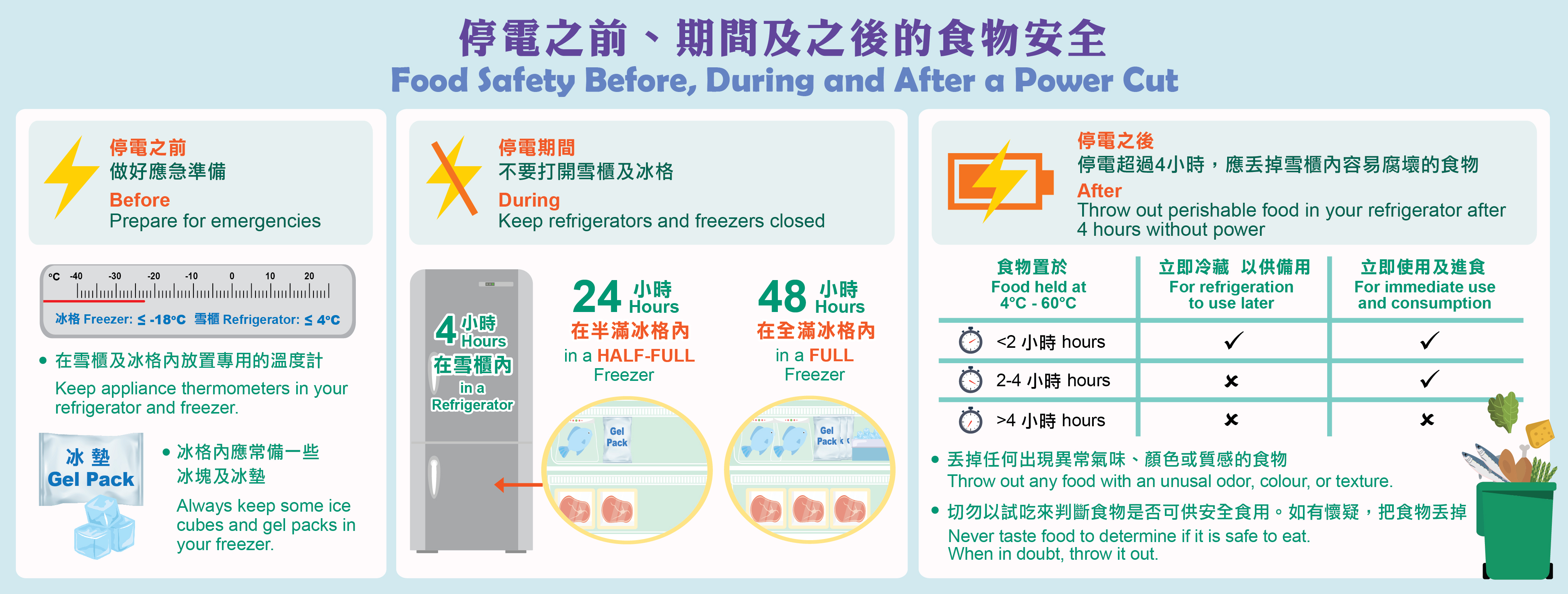
Food Safety Focus (180th Issue, July 2021) – Food Safety Platform
How to Keep Food Safe in Case of a Power Cut at Home?
Reported by Ms. Melva CHEN, Scientific Officer,
Risk Communication Section, Centre for Food Safety
While prolonged power cut is uncommon nowadays in Hong Kong, unforeseeable factors such as adverse weather or equipment failure make power cut still possible to happen without prior notice. Power disruptions can extend from minutes to hours, and many foods spoil rapidly without refrigeration. Although power cut can be inconvenient, especially if you have a lot of perishable food in your refrigerator and freezer, there is no need to panic. The following tips help you keep your food safe while waiting for the power to come back on.
Keep the Fridge and Freezer Shut During Power Cut
Without electrical power, refrigerators and freezers will lose the ability to store foods at safe temperatures. Foods stored in fridges must be at 4°C or less and freezers should store products at -18°C or less to hinder the growth of harmful bacteria and other microorganisms that can cause foodborne illness. In case of power cut, the best thing to do is simply not to open the fridge and freezer, which helps maintain the proper storage temperatures as long as possible. This is to prevent bacteria from growing rapidly in the Temperature Danger Zone ranging from 4°C to 60°C.
A common consensus among overseas food authorities such as the US Food and Drug Administration and the Food Standards Australia New Zealand is that, if the doors stay closed, food will stay safe for 2 to 4 hours in a refrigerator; 48 hours in a full freezer; and 24 hours in a half-full freezer. Therefore, knowing the time the power cut starts is useful to track how long the refrigerator and freezer have been without power; this will help you determine which foods may be safe to eat and which ones are not.
Follow the ‘4 hour/2 hour rule’ after the Power Resumes
After the power has been restored, people are advised to check the temperature of their perishable foods, considering how long they may have been out of the safe temperature range. For any potentially hazardous foods such as meat, seafood, eggs, milk, dairy products, cut fruits and cooked dishes that have been at temperatures between 4 °C and 60 °C, refrigerate or use immediately if kept for less than 2 hours; use immediately if longer than 2 hours but less than 4 hours; and toss away if more than 4 hours.
Never taste foods to determine if they are safe to eat, as they might not give off a bad taste or odour. If unsure about the safety of your perishable foods, simply discard them. On the other hand, non-perishable foods that can be stored at room temperature and are kept in the fridge or freezer may not warrant the bin in the event of a power cut. High acid foods (e.g. mustard, ketchup, jams, pickles), certain processed foods (e.g. peanut butter, butter, bread) and most dried foods are typically kept better in power blackout situations.
Prepare for Emergency in Time of Peace
In non-crisis times, make sure the refrigerator should be at 4°C or below, and the freezer at -18°C or below. Ideally, keep appliance thermometers in your refrigerator and freezer. Always keep some ice cubes and frozen gel packs in the freezer. They can keep the freezer full to help maintain the temperature, and keep foods cold should they be transferred to other locations such as a friend or relatives’ refrigerator.
Food can be very expensive to throw away but not as costly as food-borne illnesses which can cause severe health consequences as well as death. If any food is suspected to be deteriorated, it is not worth the risk, especially for young children, the elderly and those with compromised immune systems. It is always best to err on the side of caution - when in doubt, throw the food out. People should also adhere to the Five Keys to Food Safety during emergencies, protecting themselves and those around them from foodborne diseases.

Figure 2: Food safety before, during and after a power cut


